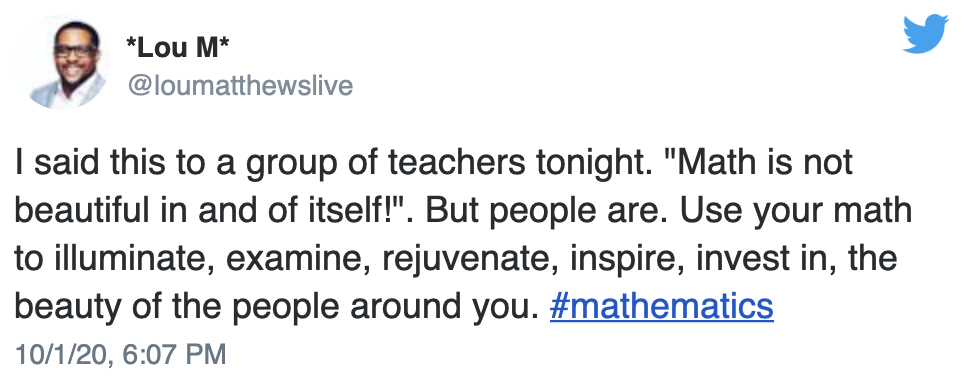|
This is the last newsletter you will read before the Presidential election of the United States of America begins on November 3rd. I take the timing of this newsletter as a huge responsibility to invoke thought in readers of the Global Math Department Newsletter, as we continue to make sense of how mathematics intersects with the world around us. And so, I’d like to start off with a reminder:
Mathematics is political.
Adolphe Quetelet was a Belgian statistician who was obsessed with collecting data about physical and social human characteristics. His preoccupation with understanding human growth led to what is now known as the Body Mass Index, but formerly known as the Quetelet Index. Yet, his main purpose was not to understand height and weight distributions among adults, but rather to define “The Average Man”. Setting distributions against the normal curve, Quetelet became hyper-focused on identifying what “The Normal Man” looked like in physical traits, and acted like social characteristics. But, in defining what is “normal”, one also defines what is “abnormal”. A quick google search for “the average man” quickly demonstrates how exclusionary it is to be deemed “normal” mathematically. Average according to these images means White, with brown hair, and approximately 5’10. Under this definition, the majority of the world is deemed abnormal.
By placing human beings on a binary scale, Quetelet introduced a new tactic for humans to assure that being White and male meant being the dominant human species, a tactic that could be measured precisely. Since then, the normal curve has been used to measure many physical and social attributes that were never intended to be placed on a binary scale, a scale that erases our diversity as a human race and creates a system of hierarchy.
Occuring in the 1830’s, Quetelet’s work was not the first to use mathematics for political purposes and it certainly hasn’t been the last. In more recent times, the mathematics behind algorithms has been used for many political purposes, including policing systems that disproportionately target communities of color. In the last 6 months, the politicizing of mathematics has been increasingly evident with the various ways of counting COVID-19 cases, or even the lack of reporting the data at all. Many of the decisions of how to count and what to report have been tied to who was in power of the state government, rather than what mathematics to use.
In many ways, understanding that mathematics is political can be turned into an advantage or a position of power. Yes, Quetelet had a particular motive for using the Normal curve to define normality among humans; but in doing so, he also provided a way to prove the existence of massive inequalities along the socially constructed variables of race, gender, and class. As teachers of mathematics, we must reconcile the above cases where mathematics was used to help some gain and to oppress others, and we do so through this second reminder:
Teaching mathematics is political.
As teachers, we make hundreds of decisions each day on how and what to teach our students. Each one of those decisions is viewed through our lens, perspective, and past experiences. If we were taught in a room where raising hands was required to speak, we may use some of those same practices in our classroom. If we were taught privileging procedures and speed over conceptual development, this may show up in how we teach our own students. Failure to recognize the many, many decisions that we make each day in our teaching practice is a dangerous path, one of which begins to “normalize” what we do, and abnormalize the work of other teachers.
For many of us, the curriculum that we use is decided for us. Many curriculums have a particularly political perspective that is viewed through the lens of what I am calling, “Mathematical exceptionalism”. Mathematical exceptionalism seeks to normalize the learning of mathematics as a sterile, benign learning process based in objectivity. Mathematical exceptionalism completely denies the privileging of White, Eurocentric, male mathematicians in curriculum, pedagogy, and access to upper level mathematics courses. Similar to the work of Quetelet, by using the Mathematical Exceptionalism lens for teaching mathematics, as teachers, we simultaneously define and counter-define who math is for and who it isn’t, to the detriment to the majority of the world who do not fit this definition of “normal”.
The same is true not only for who we show can do mathematics, but also for the context we use to teach with. We must be careful not to repeat the mistakes of former mathematicians: to define some of mathematics as “normal” and some of mathematics as “socially just”. Teaching students to understand and act on the mathematics of known injustices is just as much mathematics as teaching students the quadratic formula. By ab-normalizing mathematics centered on justice, we place it among the outliers and define those who teach this way as “different”. Recognizing the diversity of mathematics brings beauty and awe. As math teachers, it is just as much our job to celebrate the diversity of mathematics itself as it is to celebrate the ways and contexts with which mathematics can be taught.

It’s time to remember that math in the math classroom has always been political. Let’s honor the diversity of mathematics by teaching in a way that celebrates “the beauty of the people around you”.
And if you live in the US, don’t forget to vote.
Lauren Baucom
@Lbmathemagician
|